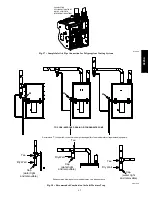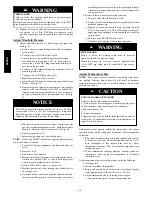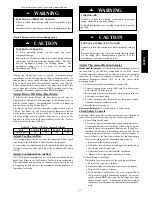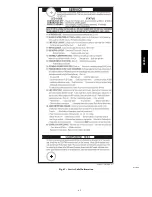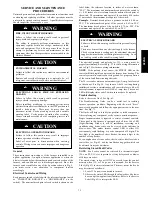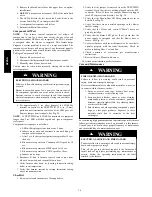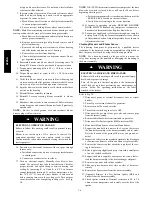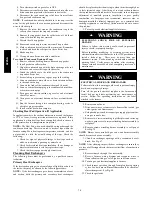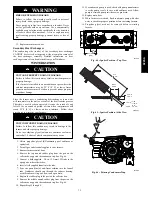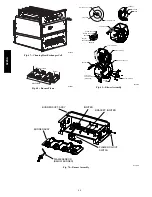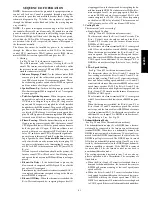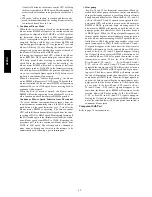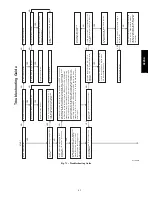
77
19. Clean burner with a brush and a vacuum.
20. Clean the flame sensor with fine steel wool (0000 grade).
Do not use sand paper or emery cloth.
To reinstall burner assembly:
1. Install the Hot Surface Igniter (HSI) and bracket in burner
assembly.
2. Install flame sensor on burner.
3. Align the edges of the one-piece burner with the slots in the
burner assembly and slide the burners forward until they are
fully seated in the burner assembly.
4. Align the orifices in the manifold assembly with the support
rings on the end of the burner.
5. Insert the orifices in the support rings of the burners.
NOTE
: If manifold does not fit flush against the burner, do not
force the manifold on the burner assembly. The burners are not
fully seated forward in the burner assembly. Remove the manifold
and check burner positioning in the burner assembly assembly
before re-installing the manifold.
6. Attach the green/yellow wire and ground terminal to one of
the manifold mounting screws.
7. Install the remaining manifold mounting screws.
8. Check the igniter alignment. See Fig. 64, 65 and 70.
9. Attach the wires to the roll-out switches.
10. Align the burner assembly with the openings in the primary
cell inlet panel and attach the burner assembly to the cell
panel.
11. Connect the wire for the flame sensor.
12. Connect the wire for the Hot Surface Igniter.
NOTE
: Use propane-resistant pipe dope to prevent leaks. Do not
use Teflon tape.
13. Install the gas pipe to the gas valve.
FIRE OR EXPLOSION HAZARD
Failure to follow this warning could result in personal
injury, death, and/or property damage.
Never purge a gas line into a combustion chamber. Never
test for gas leaks with an open flame. Use a commercially
available soap solution made specifically for the detection
of leaks to check all connections. A fire or explosion may
result causing property damage, personal injury or loss of
life.
!
WARNING
14. Check for gas leaks with a commercially available soap so-
lution made specifically for the detection of leaks.
15. Turn gas on at electric switch on gas valve and at external
shut-off or meter
16. Turn power on at external disconnect, fuse or circuit break-
er.
17. Run the furnace through two complete heating cycles to
check for proper operation
18. Install control door when complete.
Servicing Hot Surface Igniter
The igniter does
NOT
require annual inspection. Check igniter
resistance before removal. Refer to Fig. 64, 65 and 70.
1. Turn off gas and electrical supplies to furnace.
2. Remove control door.
3. Disconnect igniter wire connection.
4. Check igniter resistance. Igniter resistance is affected by
temperature. Only check resistance when the igniter is at
room temperature.
a. Using an ohm meter, check resistance across both igniter
leads in connector.
b. Cold reading should be between 40 ohms and 70 ohms.
5. Remove igniter assembly.
a. Using a 1/4--in. driver, remove the two screws securing the
igniter mounting bracket to the burner assembly See Fig.
70.
b. Carefully withdraw the igniter and bracket assembly
through the front of the burner assembly without striking
the igniter on surrounding parts.
c. Inspect igniter for signs of damage or failure.
d. If replacement is required, remove the screw that secures
the igniter on igniter bracket and remove the igniter.
6. To replace igniter and bracket assembly, reverse items 5a
through 5d.
7. Reconnect igniter harness to the igniter, dressing the igniter
wires to ensure there is no tension on the igniter itself. See
Fig. 70.
8. Turn on gas and electrical supplies to furnace.
9. Verify igniter operation by initiating control board self--test
feature or by cycling thermostat.
10. Replace control door.
Flushing Collector Box and Drainage System
ELECTRICAL SHOCK AND FIRE HAZARD
Failure to follow this warning could result in personal injury,
death, and/or property damage.
Turn off the gas and electrical supplies to the furnace and
install lockout tag before performing any maintenance or
service. Follow the operating instructions on the label
attached to the furnace.
!
WARNING
1. Turn off gas and electrical supplies to furnace.
2. Remove control door.
3. Disconnect pressure switch tube from pressure switch port.
NOTE:
Ensure the pressure switch tube disconnected from the
pressure switch is higher than the collector box opening or water
will flow out of tube.
4. Remove the collector box plug from the top port on the up-
per corner of the collector box. See Fig. 66.
5. Attach a funnel with a flexible tube to port on the collector
box.
6. Flush inside of collector box with water until discharge wa-
ter from condensate trap is clean and runs freely.
7. Repeat steps 4 thru 6 with middle plug on upper corner of
collector box.
8. Remove the pressure switch tube from the collector box.
NOTE
: Do
NOT
blow into tube with tube connected to the
pressure switch.
9. Clean pressure switch port on collect box with a small wire.
Shake any water out of pressure switch tube.
10. Reconnect tube to pressure switch and pressure switch port.
11. Remove the relief tube from the port on the collector box
and the trap.
12. Clean the relief port on collect box and the trap with a small
wire. Shake any water out of the tube.
13. Reconnect relief tube to trap and collector box ports.
Cleaning Condensate Drain and Trap
NOTE
: If the condensate trap is removed, a new gasket between
the trap and collector box is required. Verify a condensate trap
gasket is included in the service kit or obtain one from your local
distributor.
1. Disconnect power at external disconnect, fuse or circuit
breaker.
2. Turn off gas at external shut-off or gas meter.
3. Remove control door and set aside.
922SA

